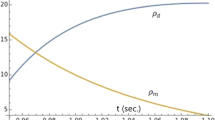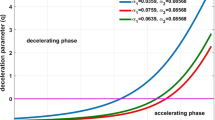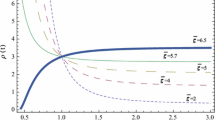Abstract
In this paper, we have presented a power law scaling Kaluza-Klein cosmological model dominated by two interacting perfect fluid components during expansion. Barotropic equations of state for pressure and density are considered to get determinate solutions of the field equations. We have shown that the components are not conserved separately because of mutual interaction between the two fluids, and the energy densities are proportional to .
Similar content being viewed by others
Avoid common mistakes on your manuscript.
Background
It is supposed that the densities of two components, the dark matter and the dark energy, dominate the total energy density of the universe [1–4]. These universes are modeled with perfect fluids and with mixtures of non-interacting fluids [5–9] under the assumption that there is no energy transfer among the components. But no observational data confirms this. This inspires us to study general properties of cosmological models containing more than one fluid which interact with each other.
The interaction between dust-like matter and radiation was first considered by Tolman [10] and Davidson [11]. The late time acceleration of the universe [12–14] and the coincidence problem [15–17] were explained by the energy transfer among the fluids. Gromov et al. [18] studied cosmological models with decay of massive particles into radiation or with matter creation. Cataldo et al. [19] considered the simplest non-trivial cosmological scenarios for an interacting mixture of two cosmic fluids described by power law scale factors, i.e., the expansion (contraction) as a power law in time. An interacting and non-interacting two-fluid scenario for dark energy in an FRW universe with constant deceleration parameter had been recently described by Pradhan et al. [20].
The Kaluza-Klein theory was introduced to unify Maxwell’s theory of electromagnetism and Einstein's gravity theory by adding the fifth dimension. Kaluza-Klein theory has been regarded as a candidate of fundamental theory due to its potential function to unite the fundamental interactions. Kaluza-Klein cosmological models have been studied with different matters [21–25]. In Kaluza-Klein theory, the inflation was considered [26], the cosmological constant problem was studied, [27] and the Schwarzschild solution for three space and n dimensions were formed [28]. String cloud and domain walls with quark matter in N-dimensional Kaluza-Klein cosmological model have also been studied [29].
Generally, the power law cosmologies are defined by the growth of the cosmological scale factor as a(t) = tα. For α > 0, the universe is expanding, whereas for α < 0, the universe is contracting (t > 0). The Hubble parameter and the deceleration parameter completely describe the behavior of the universe in power law cosmologies. For a(t) = tα, it reduces to the form which implies that the universe expands with a constant velocity for α = 1. The universe expands with an accelerated expansion for α > 1, since, if the expansion is speeding up, the deceleration parameter must be negative.
A simple inflationary model characterized by a period in which the scale factor is a power law in time with α > 1 was considered by [30, 31]. There is a class of cosmological models which dynamically solve the cosmological constant problem where the scale factor grows as a power law in time regardless of the matter content.
The aim of this paper is to investigate the simplest non-trivial cosmological scenario for an interacting mixture of two cosmic fluids described by power law scale factors. Here, we have shown that the mutual exchange of energy between two perfect fluids can be described by energy densities which are proportional to and the interacting term proportional to . Due to consideration of interacting fluids, we get the energy densities evolve at the same rate and their ratio is constant. This satisfies the so-called cosmological coincidence problem.
Field equations
We consider the Kaluza-Klein type metric as
where a and b are scale factors and are functions of cosmic time t.
The Einstein field equations are
where R ij is the Ricci tensor, R is the Ricci scalar, and T ij is energy momentum tensor.
The energy momentum tensor for two fluids is given by
with components
where p1, p2, and ρ1 , ρ2 are pressures and densities of two fluids satisfying barotropic equations of state
with ω1 and ω2 are constant state parameters, where 0 ≤ ω1, ω2 ≤ 1, and ω1 ≠ ω2.
The field Equation 2 with Equations 1 and 3 reduce to
where overhead dot represents derivative with respect to cosmic time t.
The conservation law T j ij = 0 implies that the two components ρ1 and ρ2 interact through the interacting term Q as follows:
The nature of the interacting term Q is not clear at all.
If Q > 0, then there exist an energy transfer from the fluid ρ2 to the fluid ρ1. If Q < 0, then there exist an energy transfer from the fluid ρ1 to the fluid ρ2. If Q = 0, then we have two non-interacting fluids, each satisfying the standard conservation equation separately. We consider different forms of the interacting term Q for solving these equations. By putting Q = 0 in Equations 8 and 9, we get and , where c1 and c2 are constants of integration.
Solutions of the field equations
In order to get determinate solution, we consider the relation between expansion (θ) and shear tensor (σ). This condition leads to a = bk which implies
where k is arbitrary constant usually assumed to take positive values only and it takes care of anisotropic nature of the model.
Here, and are the directional Hubble parameters.
So, the mean Hubble parameter is defined as .
Using Equation 10, the field Equations 5 to 7 reduce to
Now, we define spatial volume as
where α is a constant parameter which gives .
If α = 1, then q = 2, .i.e., there is decelerating universe. Whereas, for α = 3, we get q = 0, which means universe is undergoing accelerated expansion.
From Equations 9 and 10, we obtain
The interacting term is given by
Using Equations 15 and 16 in Equation 4, we get
If we require simultaneously ρ1 ≥ 0 and ρ2 ≥ 0, we obtain the following possible conditions:
and
The constraints (20) on the state parameter using Equation 17 give Q < 0 (for w1 < w2). Therefore, the energy is transferred from a dark fluid or a phantom fluid to another matter component.
Also, we consider the behavior of the constant ratio r of energy densities which is a function of the model parameters w1 and w2 given as .
As the energy densities ρ1 and ρ2 are proportional to (), the ratio is always constant. Now, we consider specific two fluid interactions.
Dust-perfect fluid interaction (w1= 0, w2≠ 0)
Here, we consider the interaction of dust with any other perfect fluid. So, we have w1 = 0, and w2 is a free parameter.
The Equations 15 and 16 give the dust (d) and a perfect fluid (pf) interacting configurations with the equations of state pd = 0 and ppf = ω2ρpf.
Equations 17, 18, and 19 reduce to
For simultaneous fulfillment of the conditions ρ1 ≥ 0 and ρ2 ≥ 0, we must have
As a specific example, we consider the dust-radiation interaction then put and we get
Also, we get
We get positive energy densities if .
Here, we have transfer of energy from dust to radiation as the interaction term Q is negative for the same interval.
Phantom fluid-perfect fluid interaction
Now, we consider the interaction of a phantom field with any other perfect fluid. We choose as a representative cosmic fluid of phantom matter the perfect fluid given by the equation of state .
So, we put , and ω2 is a free parameter.
Therefore, Equations 15 to 17 reduce to
If the following constraints are satisfied, then we get the positive energy density for phantom fluid and perfect fluid.
i.e., when phantom fluid interacts with perfect fluid, the universe expands if w2 > −1. The transfer of energy from dust to phantom matter takes place as the interacting term Q is positive.
As a specific example, we consider the interaction of this kind of phantom matter with a dust distribution. So now, we have then
and
To get simultaneous positive densities, we must have 0 < α < 2. The interacting term Q is positive for α < 2 which means that there is transfer of energy from dust to phantom matter.
The effective fluid interpretation
The effective fluid interpretation and the interaction of the two-fluid mixture are associated here. This is done by equating the sum of pressures p1 and p2 with an effective pressure p. We get
We have the equation of state
where γ is a constant effective state parameter.
It should be noted that the equation of the state of the associated effective fluid is not produced by physical particles and their interactions [9].
The effective state parameter γ is related to the parameter α by
Hence, the effective state parameter γ → −1 as α → ± ∞ for all positive values of k.
Conclusions
In this paper, we have provided a detailed description for Kaluza-Klein power law scaling cosmological model dominated by two interacting perfect fluid components during the expansion. In this mathematical description, we have shown that for dust-radiation interacting cosmological model is dominated by dust or radiation throughout all evolution. When α < 2, energy transfer takes place from dust to the phantom fluid.
The energy densities of the two interacting perfect fluid components are proportional to (), and the interaction term is proportional to () in all cases. We have also shown that the effective state parameter γ is a function of α by investigating the effective fluid interaction in the model.
Authors’ information
KSA is working as a professor and the head of the Department of Mathematics, SGB Amravati University, Amravati, India. MVD is working as an associate professor and the head of the Department of Mathematics, Bharatiya Mahavidyalaya, Amravati, India. SMB is working as an assistant professor in the Department of Mathematics, Sipna College of Engineering and Technology, Amravati, India.
References
Wood-Vasey WM, Miknaitis G, Stubbs CW, Jha S, Riess AG, Garnavich PM, Kirshner RP, Aguilera C, Becker AC, Blackman JW, Blondin S, Challis P, Clocchiatti A, Conlet A, Covarrubias R, Davis TM, Filippenko AV, Foley RJ, Garg A, Hicken M, Krisciunas K, Leibundgut B, Matheson T, Li W, Miceli A, Narayan G, Pignata G, Prieto JL, Rest A, Salvo ME: Observational constraints on the nature of dark energy - first cosmological results from the ESSENCE Supernove survey. Astrophys. J. 2007, 666: 694. 10.1086/518642
Corasaniti PS, Kunz M, Parkinson D, Copeland EJ, Bassett BA: Foundations of observing dark energy dynamics with the wilkinson microwave anisotropy probe. Phys. Rev. D 2004, 70: 083006.
Peebles PJE, Ratra B: The cosmological constant and dark energy. Rev. Mod. Phys. 2003, 75: 559. 10.1103/RevModPhys.75.559
Perlmutter S, Turner MS, White MJ: Constraining dark energy with type ia supernovae and large-scale structure. Phys. Rev. Lett. 1999, 83: 670. 10.1103/PhysRevLett.83.670
Gunzig E, Nesteruk AV, Stokley M: Inflationary cosmology with two component fluid and thermodynamics. Gen. Rel. Grav. 2000, 32: 329. 10.1023/A:1001939611746
Goliath M, Nilsson US: Isotropization of two component fluids. J Math. Phys. 2000, 41: 6906. 10.1063/1.1289829
Gavrilov VR, Meinikov VN: Abdyrakyhmanov Gen, ST: Friedmann universe with dust and scalar field. Rel. Grav. 2004, 36: 1579.
Pinto-Neto N, Santini ES, Falciano FT: An inflationary non-singular quantum cosmological model. Phys. Lett. A 2005, 344: 131. 10.1016/j.physleta.2005.06.080
Bozza V, Veneziano G: Regular two component bouncing cosmologies and perturbations therein. JCAP 2005, 0509: 007.
Tolman RC: Relativity. Thermodynamics and Cosmology: Clarendon Press, London; 1934.
Davidson W: The cosmological implications of the recent counts of radio sources: an evolutionary model. Mon. Not. R. Astron. Soc. 1962, 124: 79.
Armendariz-Picon C, Mykhanov VF, Steinvardt PJ: Dynamical solution to the problem of a small cosmological constant and late time cosmic acceleration. Phys. Lett. 2000, 85: 4438. 10.1103/PhysRevLett.85.4438
Bean R, Magueijo : Dilation derived quintessence scenario leading naturally to late-time acceleration of the universe. J: Phys. Lett. B 2001, 517: 177. 10.1016/S0370-2693(01)00966-2
Chimento LP, Jakubi AS, Pavon D, Zimdahi W: Interacting quintessence solution to the coincidence problem. Phys Rev. D 2003, 67: 083513.
Guo ZK, Zhang YZ: Interacting phantom energy. Phys. Rev. D 2005, 71: 023501.
Pavon D, Zimdahl W: Holographic dark energy and cosmic coincidence. Phys. Lett. B 2005, 628: 206. 10.1016/j.physletb.2005.08.134
Berger MS, Shojaei H: Interacting dark energy and the cosmic coincidence problem. Phys. Rev. D 2006, 73: 083528.
Gromov A, Baryshev Y, Teerikorpi P: Two fluid matter-quintessence FLRW models: energy transfer and the equation of state of the universe. Astron. Astrophys. 2004, 415: 813. 10.1051/0004-6361:20031693
Cataldo M, Minning P, Mella P, Saavedra J: Interacting cosmic fluids in power–law Friedmann-Robertson-Walker cosmological models. Arxiv.org. (2008). Accessed 7 Mar 2008 http://arxiv.org/pdf/0803.1086.pdf Arxiv.org. (2008). Accessed 7 Mar 2008
Pradhan A, Amirhashchi H, Saha B: An interacting two-fluid scenario for dark energy in FRW universe. Astrophys. Space Sci. 2011, 33: 1.
Chi LK: New cosmological models in the five-dimensional space-time-mass gravity theory. Gen. Rel. Gravity 1990, 22: 1347. 10.1007/BF00756834
Coley AA: Higher dimensional vacuum cosmologies. Astrophys. J. 1994, 427: 585.
Fukui T: 5-D geometrical property and 4-D property of matter. Gen. Rel. Grav. 1993, 25: 931. 10.1007/BF00759193
Liu H, Wesson PS: Cosmological solutions and their effective properties of matter in Kaluza-Klein theory. Int. J. Mod. Phys. 1994, D3: 627.
de Leon P: J: Cosmological models in a Kaluza-Klein theory with variable rest mass. Gen. Rel. Grav.. 1988, 20: 539.
Li LX, Gott I, Richard J: Inflation in Kaluza-Klein theory: relation between the fine-structure constant and the cosmological constant. Phys. Rev. 1998, D58: 103513.
Wesson PS, Liu H: The cosmological constant problem and Kaluza-Klein theory. Int. J. Mod. Phys. 2001, D10: 905.
Palatnik DM: Schwarzschild or Kerr solution in 3-dim space and N-dim time. Arxiv.org. v4.pdf (2009). arXiv:gr-qc/0703088v4. Accessed 1 Aug 2009 http://arxiv.org/pdf/gr-qc/0703088 Arxiv.org. v4.pdf (2009). arXiv:gr-qc/0703088v4. Accessed 1 Aug 2009
Adhav KS, Nimkar AS, Dawande MV: String cloud and domain walls with quark matter in n dimensional Kaluza-Klein cosmological model. Int. J. Thero. Phys. 2008, 47: 2002–2010. 10.1007/s10773-007-9644-3
Abbott LF, Wise MB: Constraints on generalized inflationary cosmologies. Nuc. Phys. B 1984, 244: 541. 10.1016/0550-3213(84)90329-8
Lueehin F, Matarrese S: Primordial generation of non-Gaussian adiabatic perturbations. Phys. Rev. D 1985, 32: 1316. 10.1103/PhysRevD.32.1316
Acknowledgment
The authors are grateful to UGC, New Delhi for granting the financial assistance through Major Research Project.
Author information
Authors and Affiliations
Corresponding author
Additional information
Competing interests
The authors declare that they have no competing interests.
Authors’ contributions
All calculations, derivations of the various results and their verifications were carried out by all authors. All authors read and approved the final manuscript.
Rights and permissions
Open Access This article is distributed under the terms of the Creative Commons Attribution 2.0 International License (https://creativecommons.org/licenses/by/2.0), which permits unrestricted use, distribution, and reproduction in any medium, provided the original work is properly cited.
About this article
Cite this article
Adhav, K.S., Dawande, M.V. & Borikar, S.M. Kaluza-Klein interacting cosmic fluid cosmological model. J Theor Appl Phys 6, 33 (2012). https://doi.org/10.1186/2251-7235-6-33
Received:
Accepted:
Published:
DOI: https://doi.org/10.1186/2251-7235-6-33




